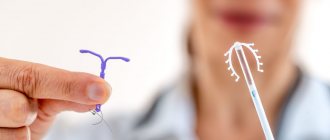MINIZISTON 20 FEM
Directions for use and doses
When and how to take the tablets
The calendar pack contains 21 tablets. In the package, each tablet is marked with the day of the week on which it should be taken. Take the tablets orally at the same time every day with a small amount of water. Follow the direction of the arrow until all 21 tablets have been taken. You do not take the drug for the next 7 days. Menstruation (withdrawal bleeding) should begin within these 7 days. Usually it begins 2-3 days after taking the last tablet of Miniziston 20 fem. After a 7-day break (on the 8th day), start taking the tablets from the next pack, even if the bleeding has not stopped yet. This means that you will always start a new pack on the same day of the week, and that your withdrawal bleed will occur on approximately the same day of the week each month.
Reception of the first package of Miniziston 20 fem
— When no hormonal contraceptive was used in the previous month
Start taking Miniziston 20 fem on the first day of the cycle, that is, on the first day of menstrual bleeding. Take the pill that is marked with the appropriate day of the week. Then take the pills in order. You can also start taking it on days 2-5 of the menstrual cycle, but in this case you must use an additional barrier method of contraception (condom) during the first 7 days of taking the pills from the first package.
— When switching from other combined oral contraceptives, vaginal ring or contraceptive patch
You can start taking Miniziston 20 fem the day after you take the last tablet of the current package of combined oral contraceptives (i.e. without interruption). If the current package contains 28 tablets, you can start taking Miniziston 20 fem the next day after taking the last hormone-containing tablet of the contraceptive you are taking. If you are not sure which pill it is, ask your doctor. You can also start taking it later, but in no case later than the next day after the usual break in taking (for drugs containing 21 tablets) or after taking the last inactive tablet (for drugs containing 28 tablets per package). Miniziston 20 fem should be taken start on the day the vaginal ring or patch is removed, but no later than the day when a new ring is to be inserted or a new patch is applied.
— When switching from oral contraceptives containing only gestagen (mini-pills)
You can stop taking the mini-pill on any day and start taking Minisiston 20 Fem the next day at the same time. During the first 7 days of taking the pills, you must also use an additional barrier method of contraception.
— When switching from an injectable contraceptive, implant or progestogen-releasing intrauterine device (IUD)
Start taking Miniziston 20 fem on the day your next injection is due or on the day your implant or IUD is removed. During the first 7 days of taking the pills, you must also use an additional barrier method of contraception.
— After childbirth
If you have just given birth, your doctor may recommend that you wait until the end of your first normal menstrual cycle before starting Miniziston 20 fem. Sometimes, on the recommendation of a doctor, you can start taking the drug earlier.
— After spontaneous miscarriage or abortion in the first trimester of pregnancy
Check with your doctor. It is usually recommended to start taking it immediately.
Taking missed pills
— If the delay in taking the next pill is less than 12 hours, the contraceptive effect of Miniziston 20 fem is maintained. Take the pill as soon as you remember. Take the next tablet at your usual time.
— If the delay in taking the pill is more than 12 hours, contraceptive protection may be reduced. The more pills in a row are missed, and the closer this missed dose is to the start or end of the dose, the higher the risk of pregnancy.
In this case, you can be guided by the following rules:
— More than one tablet from the package was forgotten
Consult your doctor.
— One tablet was missed in the first week of taking the drug
Take the missed tablet as soon as you remember (even if this means taking two tablets at the same time). Take the next tablet at your usual time. Additionally, use a barrier method of contraception for the next 7 days. If sexual intercourse took place within a week before missing a pill, the possibility of pregnancy must be taken into account. Consult your doctor immediately.
— One tablet was missed in the second week of taking the drug
Take the missed tablet as soon as you remember (even if this means taking two tablets at the same time). Take the next tablet at your usual time. If you took your pills correctly during the 7 days preceding the first missed pill, the contraceptive effect of Miniziston 20 fem is maintained and you do not need to use additional contraceptive measures. Otherwise, as well as if you miss two or more tablets, you must additionally use barrier methods of contraception for 7 days.
— One tablet was missed in the third week of taking the drug
If all tablets have been taken correctly in the 7 days preceding the first missed pill, there is no need to use additional contraceptive methods. You can stick with either of the following two options:
1. Take the missed pill as soon as you remember (even if this means taking two pills at the same time). Take the next tablet at your usual time. Start the next pack immediately after finishing the current pack, so there is no break between packs. Withdrawal bleeding is unlikely until the second pack of tablets is gone, but spotting or breakthrough bleeding may occur on the days you take the drug.
2. Stop taking the pills from the current pack, take a break of 7 days or less (including the day you missed the pill), and then start taking the pills from the new pack.
Using this regimen, you can always start taking the tablets from the next pack on the day of the week when you usually do it.
See picture
If after a break in taking the pills you do not get your expected menstruation, you may be pregnant. Check with your doctor before you start taking tablets from a new pack.
In situations where you are advised to stop taking a combined
oral contraceptive, or when the reliability of the drug may be reduced
,
you should abstain from sexual intercourse or use a non-hormonal method of contraception (such as
a
condom or other barrier methods).
Rhythmic or temperature methods should not be used. These methods may be unreliable
because
... Taking a combined oral contraceptive causes changes in temperature and cervical mucus. Recommendations in case of vomiting and diarrhea
If you have had gastrointestinal distress (vomiting or diarrhea) within 4 hours of taking Miniziston 20 Fem tablets, the active substances may not have been completely absorbed. This situation is similar to skipping a drug dose. Therefore, follow the instructions for taking missed tablets.
Delay in the onset of menstrual bleeding
You can delay the onset of menstrual bleeding if you start taking tablets from the next package of Miniziston 20 fem immediately after finishing the current package. You can continue taking the tablets from this pack for as long as you wish or until the pack runs out. If you want menstrual-like bleeding to begin, stop taking the pills. While taking Miniziston 20 fem from the second package, spotting or breakthrough uterine bleeding may occur on the days of taking the tablets. Start the next pack after the usual 7-day break.
Changing the day of the onset of menstrual bleeding
If you take the tablets as recommended, you will have menstrual bleeding on about the same day every 4 weeks. If you want to change it, shorten (but do not lengthen) the period of time you are free from taking pills. For example, if your cycle usually starts on Friday, but in the future you want it to start on Tuesday (3 days earlier), the next pack should start 3 days earlier than usual. If your pill-free break is very short (for example, 3 days or less), withdrawal bleeding may not occur during the break. In this case, bleeding or spotting may occur while taking the tablets from the next package.
Additional information for specific patient groups
Children and teenagers
The effectiveness and safety of Miniziston 20 fem as a contraceptive have been studied in women of reproductive age. It is assumed that in the postpubertal period up to 18 years of age, the effectiveness and safety of the drug are similar to those in women after 18 years of age. The use of the drug before menarche is not indicated.
Elderly patients
Not applicable. The drug Miniziston 20 fem is not indicated after menopause.
Patients with liver disorders
Miniziston 20 fem is contraindicated in women with severe liver disease until liver function tests return to normal. See also section "Contraindications".
Patients with kidney disorders
The drug Miniziston 20 fem has not been specifically studied in patients with renal impairment. Available data do not suggest adjustment of the dosage regimen in such patients.
New possibilities of modern contraception
On October 1, 2008, within the framework of the IV Congress of Obstetricians and Gynecologists of Russia, a scientific symposium “New possibilities of modern contraception: the unknown about the known” was held, organized by the pharmaceutical company. In their reports, leading Russian gynecologists reviewed new possibilities of contraception in the treatment of premenstrual syndrome and hyperandrogenism, the adequacy and acceptability of modern oral contraceptives for permanent contraception in the younger generation, as well as issues related to the progress of contraception in general.
V.N. Prilepskaya, Doctor of Medical Sciences, Professor of the Scientific Center for Gynecology and Pediatrics named after. Academician V.I. Kulakova Rosmedtekhnologii
I.V. Kuznetsova, Doctor of Medical Sciences, Professor of MMA named after. THEM. Sechenov
Drawing. LNG-containing contraceptives in the regulation of the menstrual cycle in patients with DUB
E.V. Uvarova, Doctor of Medical Sciences, Professor of the Scientific Center for Gymology and Pediatrics named after. Academician V.I. Kulakova Rosmedtekhnologii
Progress of modern contraception and levonorgestrel
The history of the development of hormonal contraception is inextricably linked with the use of gestagens. In 1921, it was experimentally proven for the first time that corpus luteum extract contains the hormone progesterone and that progesterone in large doses can suppress ovulation. This discovery became significant in the history of not only contraception, but also reproductive science in general and served as the basis for scientific research that made it possible to synthesize progesterone.
Synthesized progestogens are different; they are divided into three large groups:
- testosterone derivatives (19-norsteroids);
- progesterone derivatives;
- spironolactone derivatives.
The properties of progestogens generally depend on their chemical structure.
Progestogens are synthetic compounds that have properties similar to natural progesterone, but have an advantage over it - they have a low metabolic rate and are slowly eliminated from the body. In view of this, progestogens can persistently suppress ovulation, have a pronounced antigonadotropic effect, and cause full-fledged secretory transformation of the endometrium.
Sex steroids are the most used hormones not only to prevent unwanted pregnancy, but also for the prevention and treatment of a number of diseases, although the main indication for their use is contraception.
The protective, or antiestrogenic, effect of progestogens makes it possible to prevent endometrial cancer, ovarian cancer and some malignant diseases of the reproductive system. These drugs are widely used to treat a number of pathological conditions, in particular dysfunctional uterine bleeding and hyperpolymenorrhea, premenstrual syndrome and others.
The spectrum of pharmacological activity of any synthetic progestogen is determined by the severity of a number of effects: antiestrogenic and gestagenic, the presence or absence of antimineralkorticoid, glucocorticoid, androgenic activity, etc. This is determined by the chemical properties of progestogens. The more drugs with new compositions are synthesized, the more opportunities we have for their differentiated use not only for the purpose of contraception, but also for the treatment of various gynecological diseases.
The main area of application of levonorgestrel is planned contraception as part of various combined oral contraceptives, implants, so-called purely progestin preparations containing only levonorgestrel and used for the purpose of emergency contraception.
Levonorgestrel is part of the hormonal releasing system Mirena, on its basis the drugs Microgynon, Triquilar, Miniziston®20 fem
and others.
Levonorgestrel is the most active of progestogens; it has high, almost 100% bioavailability, which distinguishes it from other modern gestagens. The dose that causes endometrial transformation is only 5 mg per cycle.
The half-life of levonorgestrel is 24 hours, which is sufficient time for an effective effect on the endometrium.
Interest in levonorgestrel and levonorgestrel-containing drugs has grown significantly in recent years for the reasons that this progestogen has a good pharmacological profile and pronounced gestagenic properties, which is extremely important in the management of patients with various pathological conditions.
It should be noted that levonorgestrel is one of the most well-studied modern progestogens in a large population of women in many multicenter studies and in clinical practice, which may indicate its safety.
About the therapeutic possibilities of levonorgestrel-containing contraceptives
The medicinal properties of combined oral contraceptives (COCs) are a continuation of their contraceptive properties. Suppression of ovulation is the basis for treating mid-cycle pain and reducing the risk of ovarian cancer. The antiproliferative effect of COCs is used in the treatment of endometriosis and the prevention of endometrial cancer. In addition, thinning of the endometrium leads to a decrease in the formation of tissue mediators of inflammation, a decrease in the severity of blood loss, which is important in the complex of prevention and treatment of inflammatory diseases of the pelvic organs, dysmenorrhea, menorrhagia, and iron deficiency anemia. Finally, the thinning of the endometrium, combined with the thickening of the cervical mucus, creates the opportunity to prevent inflammatory diseases of the pelvic organs.
Among these effects, the most significant from a therapeutic point of view is the antiproliferative effect of COCs on the endometrium due to the progestogen component they contain. Estrogens and progesterone have multidirectional effects on the endometrium. Estrogens in the endometrium increase the number of mitoses, enhance metabolism and thus ensure proliferation of the mucous membrane of the uterine body. Progesterone reduces the expression of steroid hormone receptors in the endometrium, including the expression of estradiol receptors, increases the conversion of estradiol to the less active estrone and thus has an antiproliferative effect. Sex hormones also interfere with the processes of intracellular and intercellular interaction, participating in autocrine and paracrine regulation.
The effect of progestin in combined contraceptives on the endometrium depends on the dose administered, the mode of administration of the progestin and its gestagenic activity. One of the “strongest” progestins is considered to be levonorgestrel, the gestagenic activity of which, calculated by the minimum dose required for secretory transformation of the endometrium, is tens of times higher than the activity of endogenous progesterone. Levonorgestrel causes secretory transformation of the endometrium, while simultaneously reducing the sensitivity of the endometrium to estradiol. With long-term continuous exposure to levonorgestrel, atrophy of the glandular epithelium is observed with simultaneous decidu-like transformation of the stroma. The features of the multifaceted effect of levonorgestrel on the endometrium make it possible to use it for diseases or conditions that require functional control of the uterine mucosa or a therapeutic effect on the endometrium.
Preparations containing levonorgestrel - combined monophasic oral contraceptive Microgynon, triphasic oral contraceptive Triquilar, intrauterine system Mirena, Miniziston®20 fem
– all of them are used not only for contraceptive, but also for medicinal purposes.
Dysfunctional uterine bleeding has the longest history of therapeutic use of levonorgestrel-containing drugs. The drug of choice for hormonal hemostasis in this case is undoubtedly Microgynon. Mirena can be used to prevent relapses of dysfunctional uterine bleeding and endometrial hyperplasia. Over 6 months of using Mirena, the volume of menstrual blood loss is reduced by 86%. The effectiveness of the levonorgestrel-containing intrauterine system in the treatment of simple endometrial hyperplasia is close to 100%.
To regulate the menstrual cycle and prevent relapses of dysfunctional uterine bleeding during puberty, Miniziston®20 fem
(see picture). The microdose of ethinyl estradiol contained in the drug is the key to good tolerability of the drug. A microdose of ethinyl estradiol is absolutely acceptable for the teenage body, when tissues are more sensitive to estrogens than in older age groups, and this ensures good cycle control.
Triquilar is characterized by a relatively higher level of estrogenic effects, so it should be considered as the drug of choice in girls with a hypoestrogenic status, and also prescribed to women with insufficient cycle control while using the low-dose combined contraceptive Microgynon.
The use of microdosed COCs is advisable for regulating the cycle and providing a contraceptive effect in the premenopausal period, provided there are no contraindications to taking estrogens; the option of choice in this age group would be Miniziston®20 fem
. If estrogen is not indicated or not desired, Mirena, a levonorgestrel-containing intrauterine system, provides an alternative choice.
Taking COCs containing the progestogen component levonorgestrel is also indicated for dysmenorrhea. The pathogenetic rationale for this prescription is the ability of progestins to influence the synthesis of prostaglandins in the endometrium.
Endometriosis is considered as an indication for the use of combined oral contraceptives. Hormonal treatment of endometriosis is based on reducing the gonadotropic function of the pituitary gland and the level of estradiol. The mechanism of therapeutic action of COCs for endometriosis is realized through a decrease in the secretion of gonadotropic hormones and steroidogenesis in the ovaries. The second component of the mechanism of therapeutic action of progestins is the antiproliferative effect on the endometrium and endometrial-like tissue. Progestins also interfere with the process of intracellular interaction, reducing the severity of the inflammatory reaction, the secretion of prostaglandins and cytokines, that is, they eliminate the cause of the pain symptom.
Other properties of COCs containing levonorgestrel include reducing the risk of uterine fibroids. Five years of combined oral contraceptives reduces the risk of developing fibroids by 17%.
Contraceptive drugs containing levonorgestrel also provide prevention of functional ovarian cysts, ovarian cancer, and uterine cancer.
It is also necessary to note the effect of COCs containing levonorgestrel in the prevention of osteoporosis. A study of bone mineral density in girls and young women found that microdosing COCs with levonorgestrel had a neutral or positive effect on bone mass accumulation. COCs help preserve bone mass in women during perimenopause.
Contraceptive drugs have a variety of positive effects, but in order to fully implement them and preserve the reproductive health of women, the selection of COCs must be carried out strictly individually.
Adequacy and acceptability of Miniziston 20 fem for permanent contraception in adolescents and young people
The Declaration of Human Rights states that adolescents have the right of access to safe and effective methods of regulating childbirth and the right to a satisfying and safe sex life. A woman always wants to have a desired child, but the peak birth rate, both previously and now, occurs at 20-25 years of age. Therefore, 3.5-8 years pass from the moment she begins sexual relations until the moment she plans a pregnancy. Speaking about contraceptive methods for adolescents, no one doubts that a condom is the only means of simultaneously preventing unplanned pregnancy and infection with STIs, including HIV and hepatitis. But reproductive health must not only be protected, but also preserved. Therefore, along with condoms, modern medicine offers combined oral contraceptives (COCs) for adolescents to preserve their reproductive reserve. The value of COCs lies in maximum protection against pregnancy with an extremely minimal number of negative effects, ease of use and affordable cost. It is also worth paying attention to the fact that COCs preserve the follicular reserve of young women. However, the majority of young and young patients motivate the choice of hormonal contraceptive drugs by the presence of non-contraceptive beneficial effects: improvement of skin condition, elimination of dysmenorrhea, premenstrual syndrome, menstrual irregularities, reduction of menstrual blood loss, prevention of genital pathology. Protection from unwanted pregnancy is in second place for them.
For contraception in adolescents and young adults, WHO criteria give preference to oral contraceptives with minimal progestogen content. Their range is quite wide, especially when it comes to the need for the therapeutic effect of the drug against the background of contraception. Therefore, an individual choice of COC is important for each patient.
But there are situations when it is advisable to pay attention to the presence of the dose of substances in these drugs and the type of progestogen in the drug. Mainly for microdosed primary administration, the minimum dose of the hormone should be sufficient to maintain estrogen-dependent reactions during puberty. In this regard, it is necessary to pay attention to the drug Miniziston®20 fem
. The drug contains a well-studied (for almost 50 years) progestogen – levonorgestrel, the dose of which (100 mcg) provides a pronounced contraceptive effect. And the dose of ethinyl estradiol, reduced to 20 mcg, turned out to be quite sufficient for high-quality control of the cycle with a minimum of adverse reactions. The drug can and should be prescribed for a long time, since along with the contraceptive effect it prevents the development of pathological processes in the uterus, including cancer, and in the mammary glands. The use of hormonal contraceptives in adolescence reduces the risk of uterine bleeding, pelvic inflammatory diseases, functional ovarian cysts, benign diseases of the mammary glands, anemia, and infertility.
About these beneficial effects of COCs using the example of Miniziston 20 fem
Not only specialists, but also the general public of our country should know. Therefore, when taking part in sexuality education, doctors should devote more time to counseling, i.e. explanatory work and psychological support for sexually active adolescents and young people. This is how we can ensure a general hygienic culture for the inhabitants of our country, which is necessary not only for comfortable living, but also for the birth of healthy citizens.



